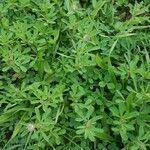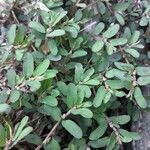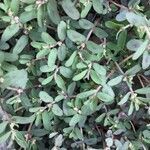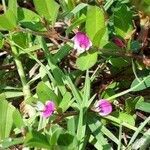Herbs, diffuse or prostrate. Stem and branchlets with downward-pointing white hairs. Stipules ovate-oblong, 3-4 mm, longer than petiole, striate, long ciliate; petiole 1-2 mm; leaflets obovate, narrowly obovate, or oblong, terminal one 0.6-2.2 cm × 3-8 mm, lateral veins dense, base nearly rounded or broadly cuneate, apex rounded, rarely emarginate. Flowers 1-3 in upper axils of leaves. Pedicel ca. 1 cm, glabrous; bracteoles 4, attached to proximal part of calyx, 1 very small bracteole placed at article of pedicel, others larger. Calyx 5-lobed. Corolla 5-6 mm; standard elliptic, base attenuate, clawed, auriculate; keel subequaling or slightly longer than standard; wings slightly shorter than keel. Legume orbicular or obovoid, slightly compressed, 3.5-5 mm, ca. 2 × as long as calyx or slightly longer, pubescent, apex mucronate. Fl. Jul-Sep, fr. Aug-Oct. 2n = 22*.
More
A herb which lays along the ground. It grows each year from seed. It is 5-30 cm high. The leaves have 3 leaflets. The leaflets vary in size and shape. They are narrowly oval and 5-15 mm long by 3-7 mm wide. The flowers are small and white. The fruit are small round pods. There is one seed.
Waste ground and roadsides all over Japan. Clayey, sandy and gravelly soils, riverbanks, roadsides and non-populated areas, always in large quantities.
More
It is a temperate climate plant. In China it grows on sandy soils below 500 m altitude. It is a widespread weed in lawns. In Sichuan and Yunnan.
Can be grown by seedlings. Seeds needs soaking.




